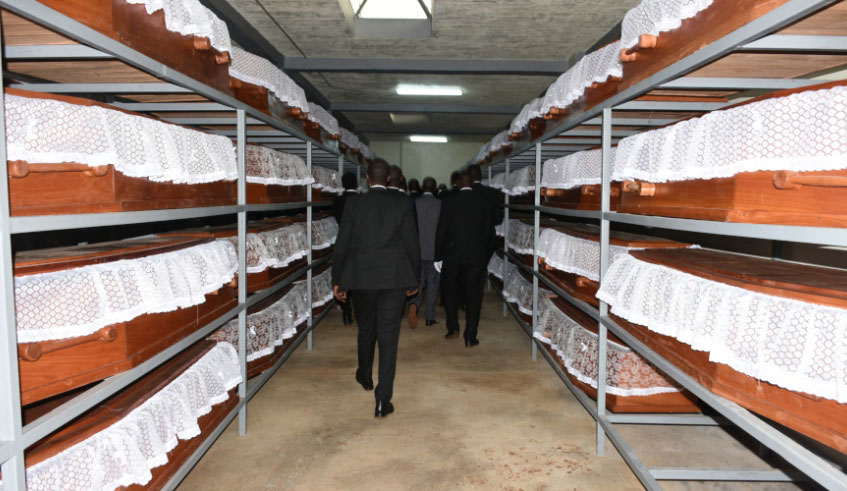

Rukumberi is surrounded by myriad water bodies; several lakes and River Akagera. This made it easy for killers to exterminate over 35,000 Tutsi, who lived, trapped there during the 1994 Genocide against the Tutsi.


Kankindi, a Hutu lady, had the kindness to hide the Tutsi. Her husband was killed as a result. The association of students and former student survivors of the Genocide (GAERG) offered her a cow (the ultimate symbol of gratitude in the Rwandan culture).
Tutsi from ‘Ubufundu’ - ‘Ubunyambiriri’ in current Southern and Western provinces, who had survived pogroms of the 60s and failed to make it to exile in neighbouring countries, were ‘deported’ to Rukumberi located in Eastern Province.
Just like other Tutsi who had survived pogroms in the North-Eastern regions were banished to Bugesera.
On the 5th of May, 1994, the survivors of Rukumberi will never forget the humanity of RPF-Inkotanyi soldiers who searched the swamps looking for Tutsi survivors to save.
The story of Rukumberi gives a complete picture of the Genocide against the Tutsi.
From this story, one understands all the steps of a genocide by understanding the history of Rukumberi. (Genocide definition: acts committed with intent to destroy, in whole or in part, a national, ethnic, racial or religious group, including the systematic harm or killing of its members, deliberately imposing living conditions that seek to bring about physical destruction in whole or in part to the group, forceful deportation, etc.)
Tutsi were banished to Rukumberi in 1960, to live with animals and the deadly Tse-tse fly. No infrastructure was ever built in the area. The people of Rukumberi used water from the lake for their survival.
Later in the early 80s, Juvenal Habyarimana (former president), resettled the ‘Abakiga’ (Hutus from the north) in nearby Sake and gave them all infrastructure (water and electricity).
There is no big distance between Sake and Rukumberi. But Rukumberi only received water and electricity after the genocide (under President Paul Kagame)
The genocide was prepared a long time ago because wherever many Tutsis were located, the MRND (then ruling party) would surround them with Abakiga, including in the mountains surrounding Bugesera, Rukumberi, Bicumbi, Kibungo, Murambi, etc.
Those Bakiga ‘neighbours’ are the ones whom when the time came, massively killed the Tutsi they surrounded in the genocide.
Rukumberi has many Tutsi families that were totally annihilated. Walking from the genocide memorial towards Lake Mugesera, you meet plaques with names of members of extinct families in abandoned plots and shrubs.
No one can speak of the story of Rukumberi without speaking of the abject cruelty of Burundian Hutu who crossed the border to lend a hand to their fellow Rwandan killers.
On May 19, the few Tutsi who survived in Rukumberi, accompanied by relatives and friends, all dressed in beautiful traditional Rwandan outfits, gathered in Rukumberi to commemorate and honor their loved ones who had been buried in temporary graves.
They were finally laid to rest this past weekend, in a new Genocide memorial.
Note by the translator...
When I read this thread, passionately told in Kinyarwanda on Noel Kambanda’s Twitter timeline yesterday, I was heartbroken. For the twenty five years that I have lived in Rwanda after the genocide, I have heard many stories of the genocide, but each one comes as more painful than the previous one.
It is only last year in 2018 that I had the courage to enter in a genocide memorial. I still haven’t managed to finish one genocide film. Although I fear it, it seems I am not done crying, it seems I never will…
For us who were in exile, the genocide remains a horrifying story, but a story nonetheless. While we lost relatives in it, our pain was like a sharp blade tearing our hearts apart. A one-time pain, leaving a scar that hurts in the rain, in April.
Unlike our relatives – the genocide survivors, it wasn’t a slow, painful, unbearable torture lasting for thirty years and the trauma of genocide; an inescapable, excruciating grief carried in one’s heart for the rest of their lives after that. We just couldn’t imagine what survivors went through. No one could.
Today our country Rwanda is at peace. No harm will ever come to Tutsi again. Or to anyone living in Rwanda. This is a promise we make to ourselves, every day.
I thought to translate this story as a gesture of appreciation to my brother Noel Kambanda. I am so glad he survived, so he can recount to us what it was like; how our people were treated. How they lived, how they were killed and how they survived.
This article is a translation of a thread posted on Noel Kambanda’s Twitter timeline (@NoelKambanda) on the day of commemoration of the massacre in Rukumberi located in Ngoma District.
The views expressed in this article are of the author.


